Corporate Strategy: Starbucks' Competitive Advantage Evaluation
VerifiedAdded on 2023/01/11
|35
|9089
|96
Report
AI Summary
This report presents a comprehensive analysis of Starbucks, focusing on the factors that contribute to its sustainable competitive advantage. It begins with an introduction outlining the research project's background, aims, and objectives, followed by a literature review that explores relevant concepts like industry life cycles, corporate governance structures, and crisis management. The study delves into primary and secondary research findings, critically reviewing the results to identify key drivers of Starbucks' success and potential areas for improvement. The report also examines corporate governance failures and proposes an action plan with specific recommendations to enhance Starbucks' competitive position and mitigate risks. Appendices include the dissertation supervision record and ethical forms, providing a complete overview of the research process.
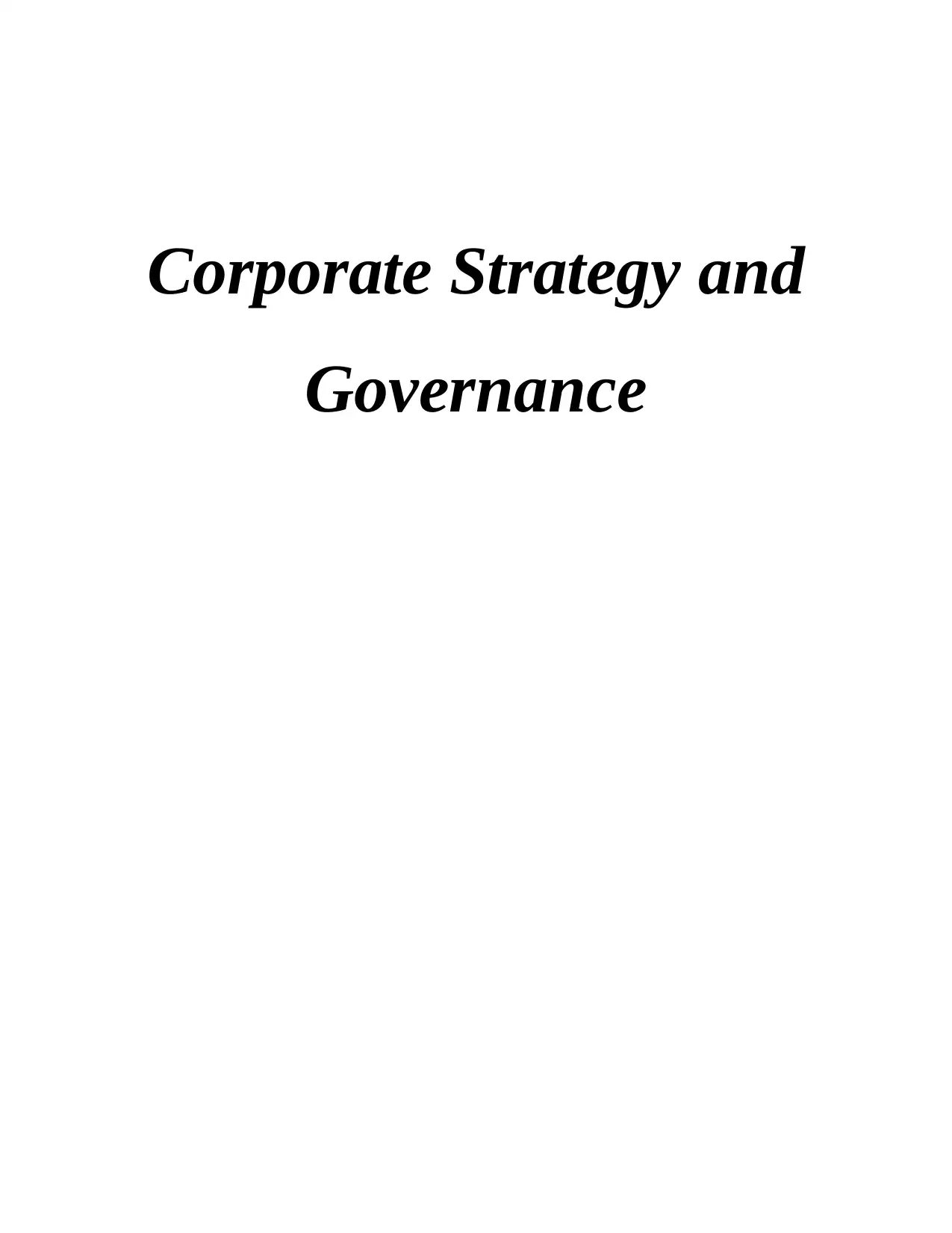
Corporate Strategy and
Governance
Governance
Paraphrase This Document
Need a fresh take? Get an instant paraphrase of this document with our AI Paraphraser
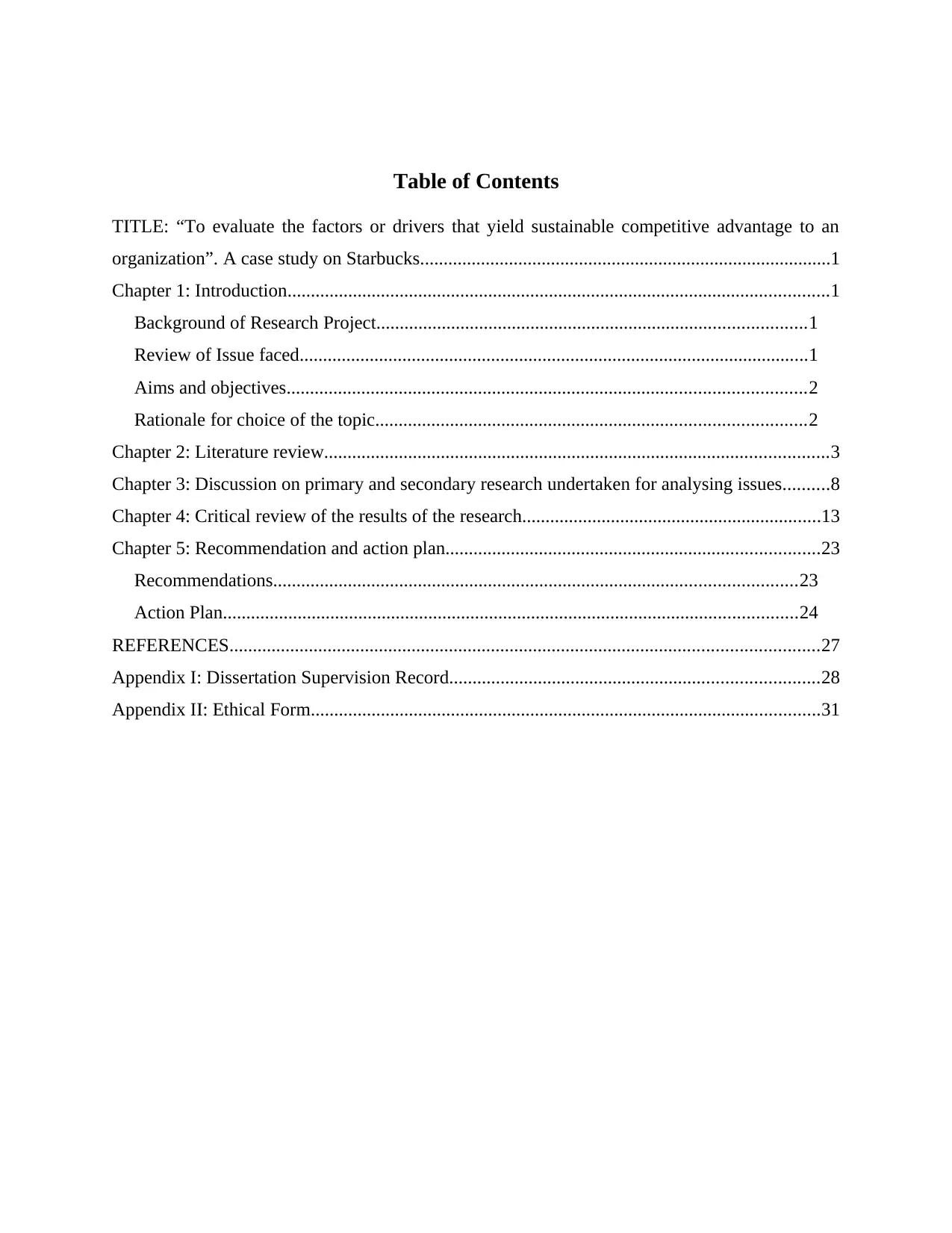
Table of Contents
TITLE: “To evaluate the factors or drivers that yield sustainable competitive advantage to an
organization”. A case study on Starbucks........................................................................................1
Chapter 1: Introduction....................................................................................................................1
Background of Research Project............................................................................................1
Review of Issue faced.............................................................................................................1
Aims and objectives...............................................................................................................2
Rationale for choice of the topic............................................................................................2
Chapter 2: Literature review............................................................................................................3
Chapter 3: Discussion on primary and secondary research undertaken for analysing issues..........8
Chapter 4: Critical review of the results of the research................................................................13
Chapter 5: Recommendation and action plan................................................................................23
Recommendations................................................................................................................23
Action Plan...........................................................................................................................24
REFERENCES..............................................................................................................................27
Appendix I: Dissertation Supervision Record...............................................................................28
Appendix II: Ethical Form.............................................................................................................31
TITLE: “To evaluate the factors or drivers that yield sustainable competitive advantage to an
organization”. A case study on Starbucks........................................................................................1
Chapter 1: Introduction....................................................................................................................1
Background of Research Project............................................................................................1
Review of Issue faced.............................................................................................................1
Aims and objectives...............................................................................................................2
Rationale for choice of the topic............................................................................................2
Chapter 2: Literature review............................................................................................................3
Chapter 3: Discussion on primary and secondary research undertaken for analysing issues..........8
Chapter 4: Critical review of the results of the research................................................................13
Chapter 5: Recommendation and action plan................................................................................23
Recommendations................................................................................................................23
Action Plan...........................................................................................................................24
REFERENCES..............................................................................................................................27
Appendix I: Dissertation Supervision Record...............................................................................28
Appendix II: Ethical Form.............................................................................................................31
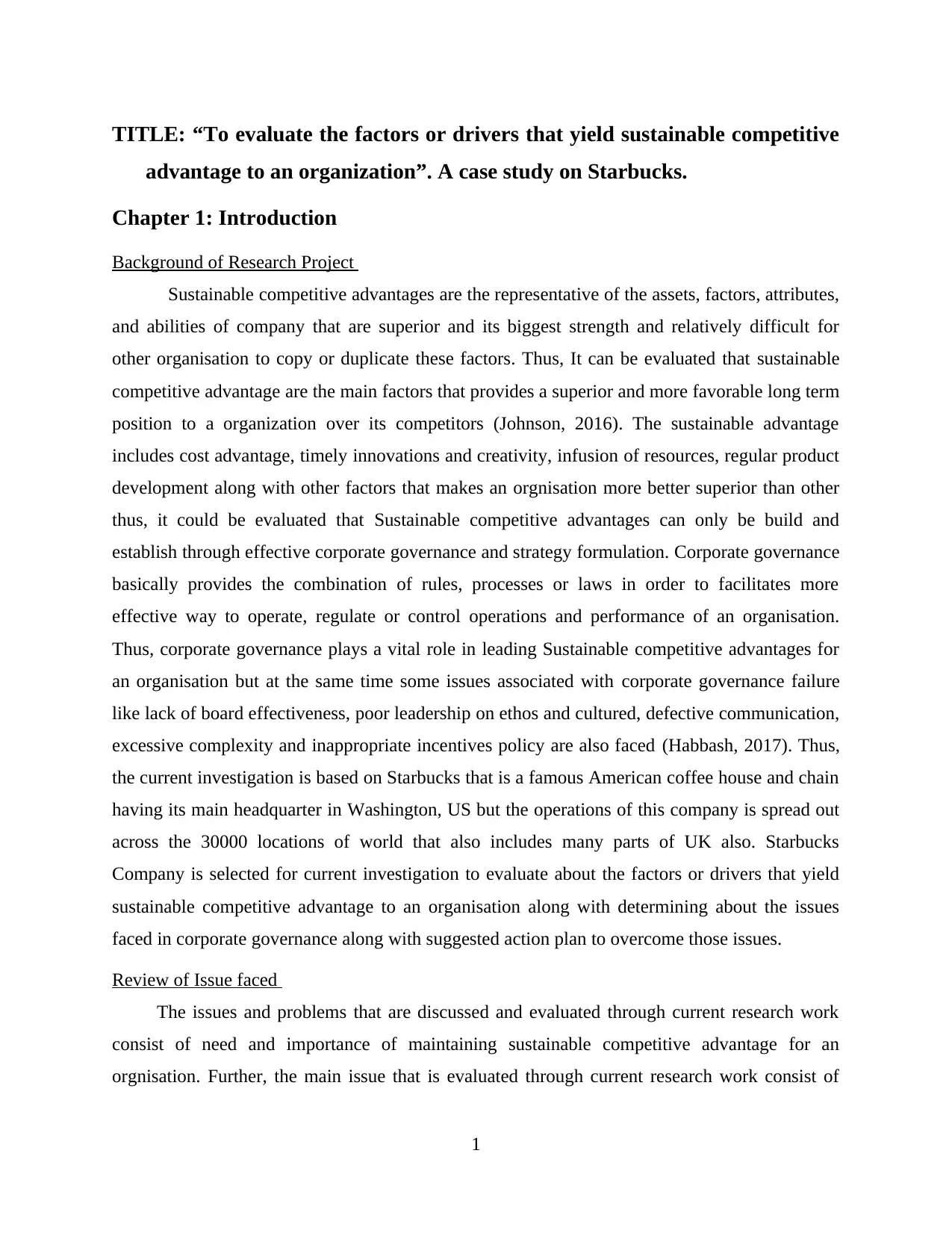
TITLE: “To evaluate the factors or drivers that yield sustainable competitive
advantage to an organization”. A case study on Starbucks.
Chapter 1: Introduction
Background of Research Project
Sustainable competitive advantages are the representative of the assets, factors, attributes,
and abilities of company that are superior and its biggest strength and relatively difficult for
other organisation to copy or duplicate these factors. Thus, It can be evaluated that sustainable
competitive advantage are the main factors that provides a superior and more favorable long term
position to a organization over its competitors (Johnson, 2016). The sustainable advantage
includes cost advantage, timely innovations and creativity, infusion of resources, regular product
development along with other factors that makes an orgnisation more better superior than other
thus, it could be evaluated that Sustainable competitive advantages can only be build and
establish through effective corporate governance and strategy formulation. Corporate governance
basically provides the combination of rules, processes or laws in order to facilitates more
effective way to operate, regulate or control operations and performance of an organisation.
Thus, corporate governance plays a vital role in leading Sustainable competitive advantages for
an organisation but at the same time some issues associated with corporate governance failure
like lack of board effectiveness, poor leadership on ethos and cultured, defective communication,
excessive complexity and inappropriate incentives policy are also faced (Habbash, 2017). Thus,
the current investigation is based on Starbucks that is a famous American coffee house and chain
having its main headquarter in Washington, US but the operations of this company is spread out
across the 30000 locations of world that also includes many parts of UK also. Starbucks
Company is selected for current investigation to evaluate about the factors or drivers that yield
sustainable competitive advantage to an organisation along with determining about the issues
faced in corporate governance along with suggested action plan to overcome those issues.
Review of Issue faced
The issues and problems that are discussed and evaluated through current research work
consist of need and importance of maintaining sustainable competitive advantage for an
orgnisation. Further, the main issue that is evaluated through current research work consist of
1
advantage to an organization”. A case study on Starbucks.
Chapter 1: Introduction
Background of Research Project
Sustainable competitive advantages are the representative of the assets, factors, attributes,
and abilities of company that are superior and its biggest strength and relatively difficult for
other organisation to copy or duplicate these factors. Thus, It can be evaluated that sustainable
competitive advantage are the main factors that provides a superior and more favorable long term
position to a organization over its competitors (Johnson, 2016). The sustainable advantage
includes cost advantage, timely innovations and creativity, infusion of resources, regular product
development along with other factors that makes an orgnisation more better superior than other
thus, it could be evaluated that Sustainable competitive advantages can only be build and
establish through effective corporate governance and strategy formulation. Corporate governance
basically provides the combination of rules, processes or laws in order to facilitates more
effective way to operate, regulate or control operations and performance of an organisation.
Thus, corporate governance plays a vital role in leading Sustainable competitive advantages for
an organisation but at the same time some issues associated with corporate governance failure
like lack of board effectiveness, poor leadership on ethos and cultured, defective communication,
excessive complexity and inappropriate incentives policy are also faced (Habbash, 2017). Thus,
the current investigation is based on Starbucks that is a famous American coffee house and chain
having its main headquarter in Washington, US but the operations of this company is spread out
across the 30000 locations of world that also includes many parts of UK also. Starbucks
Company is selected for current investigation to evaluate about the factors or drivers that yield
sustainable competitive advantage to an organisation along with determining about the issues
faced in corporate governance along with suggested action plan to overcome those issues.
Review of Issue faced
The issues and problems that are discussed and evaluated through current research work
consist of need and importance of maintaining sustainable competitive advantage for an
orgnisation. Further, the main issue that is evaluated through current research work consist of
1
⊘ This is a preview!⊘
Do you want full access?
Subscribe today to unlock all pages.

Trusted by 1+ million students worldwide
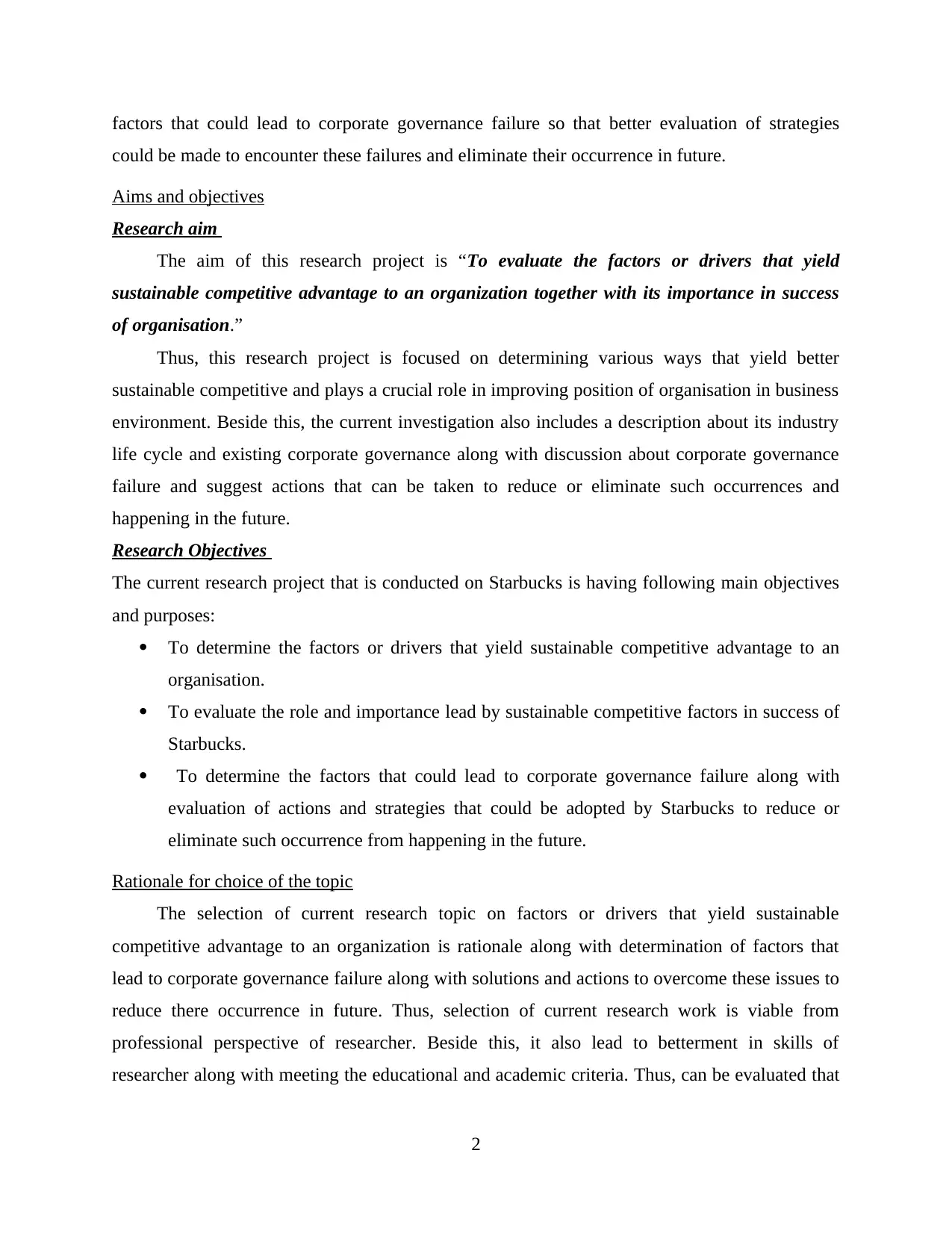
factors that could lead to corporate governance failure so that better evaluation of strategies
could be made to encounter these failures and eliminate their occurrence in future.
Aims and objectives
Research aim
The aim of this research project is “To evaluate the factors or drivers that yield
sustainable competitive advantage to an organization together with its importance in success
of organisation.”
Thus, this research project is focused on determining various ways that yield better
sustainable competitive and plays a crucial role in improving position of organisation in business
environment. Beside this, the current investigation also includes a description about its industry
life cycle and existing corporate governance along with discussion about corporate governance
failure and suggest actions that can be taken to reduce or eliminate such occurrences and
happening in the future.
Research Objectives
The current research project that is conducted on Starbucks is having following main objectives
and purposes:
To determine the factors or drivers that yield sustainable competitive advantage to an
organisation.
To evaluate the role and importance lead by sustainable competitive factors in success of
Starbucks.
To determine the factors that could lead to corporate governance failure along with
evaluation of actions and strategies that could be adopted by Starbucks to reduce or
eliminate such occurrence from happening in the future.
Rationale for choice of the topic
The selection of current research topic on factors or drivers that yield sustainable
competitive advantage to an organization is rationale along with determination of factors that
lead to corporate governance failure along with solutions and actions to overcome these issues to
reduce there occurrence in future. Thus, selection of current research work is viable from
professional perspective of researcher. Beside this, it also lead to betterment in skills of
researcher along with meeting the educational and academic criteria. Thus, can be evaluated that
2
could be made to encounter these failures and eliminate their occurrence in future.
Aims and objectives
Research aim
The aim of this research project is “To evaluate the factors or drivers that yield
sustainable competitive advantage to an organization together with its importance in success
of organisation.”
Thus, this research project is focused on determining various ways that yield better
sustainable competitive and plays a crucial role in improving position of organisation in business
environment. Beside this, the current investigation also includes a description about its industry
life cycle and existing corporate governance along with discussion about corporate governance
failure and suggest actions that can be taken to reduce or eliminate such occurrences and
happening in the future.
Research Objectives
The current research project that is conducted on Starbucks is having following main objectives
and purposes:
To determine the factors or drivers that yield sustainable competitive advantage to an
organisation.
To evaluate the role and importance lead by sustainable competitive factors in success of
Starbucks.
To determine the factors that could lead to corporate governance failure along with
evaluation of actions and strategies that could be adopted by Starbucks to reduce or
eliminate such occurrence from happening in the future.
Rationale for choice of the topic
The selection of current research topic on factors or drivers that yield sustainable
competitive advantage to an organization is rationale along with determination of factors that
lead to corporate governance failure along with solutions and actions to overcome these issues to
reduce there occurrence in future. Thus, selection of current research work is viable from
professional perspective of researcher. Beside this, it also lead to betterment in skills of
researcher along with meeting the educational and academic criteria. Thus, can be evaluated that
2
Paraphrase This Document
Need a fresh take? Get an instant paraphrase of this document with our AI Paraphraser
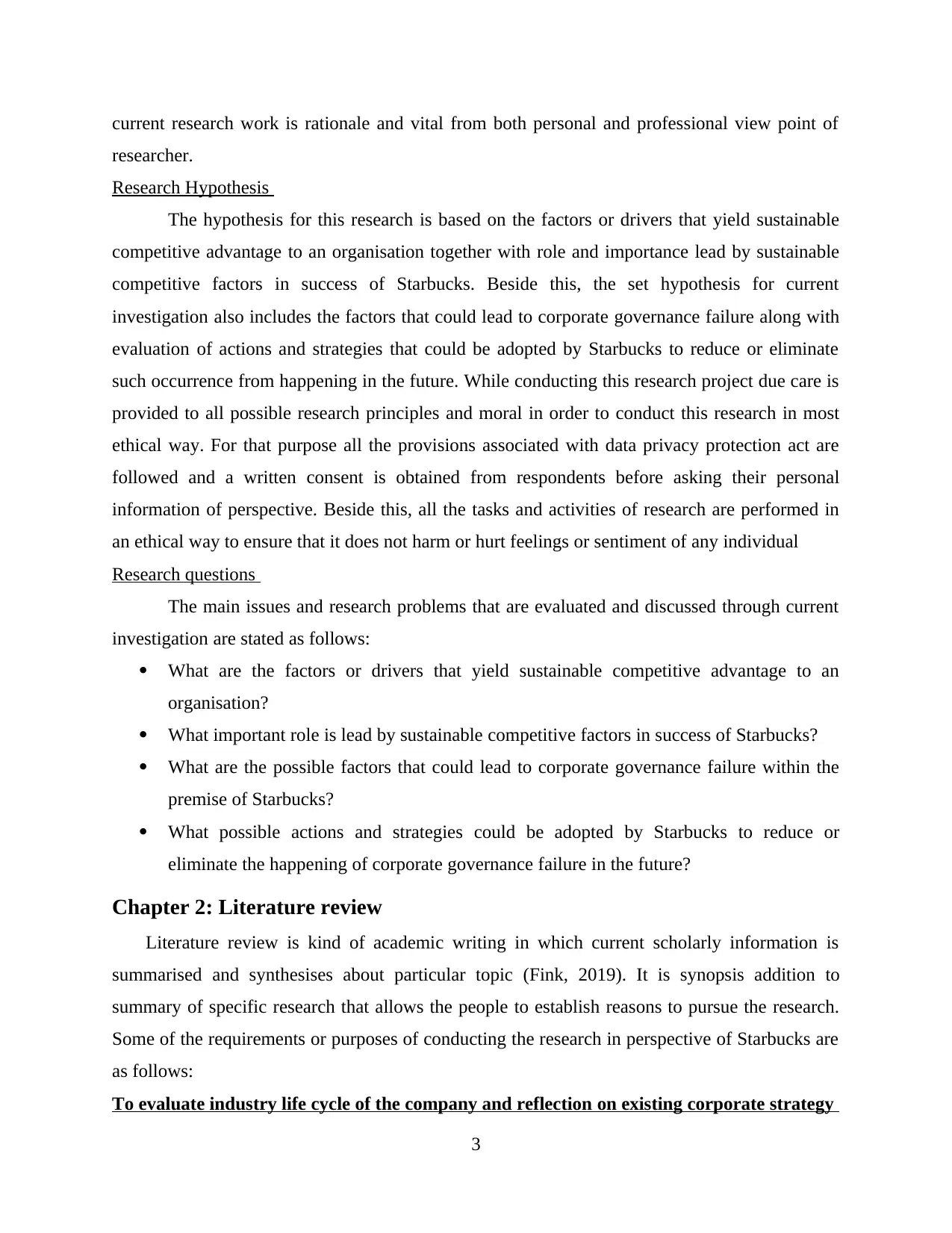
current research work is rationale and vital from both personal and professional view point of
researcher.
Research Hypothesis
The hypothesis for this research is based on the factors or drivers that yield sustainable
competitive advantage to an organisation together with role and importance lead by sustainable
competitive factors in success of Starbucks. Beside this, the set hypothesis for current
investigation also includes the factors that could lead to corporate governance failure along with
evaluation of actions and strategies that could be adopted by Starbucks to reduce or eliminate
such occurrence from happening in the future. While conducting this research project due care is
provided to all possible research principles and moral in order to conduct this research in most
ethical way. For that purpose all the provisions associated with data privacy protection act are
followed and a written consent is obtained from respondents before asking their personal
information of perspective. Beside this, all the tasks and activities of research are performed in
an ethical way to ensure that it does not harm or hurt feelings or sentiment of any individual
Research questions
The main issues and research problems that are evaluated and discussed through current
investigation are stated as follows:
What are the factors or drivers that yield sustainable competitive advantage to an
organisation?
What important role is lead by sustainable competitive factors in success of Starbucks?
What are the possible factors that could lead to corporate governance failure within the
premise of Starbucks?
What possible actions and strategies could be adopted by Starbucks to reduce or
eliminate the happening of corporate governance failure in the future?
Chapter 2: Literature review
Literature review is kind of academic writing in which current scholarly information is
summarised and synthesises about particular topic (Fink, 2019). It is synopsis addition to
summary of specific research that allows the people to establish reasons to pursue the research.
Some of the requirements or purposes of conducting the research in perspective of Starbucks are
as follows:
To evaluate industry life cycle of the company and reflection on existing corporate strategy
3
researcher.
Research Hypothesis
The hypothesis for this research is based on the factors or drivers that yield sustainable
competitive advantage to an organisation together with role and importance lead by sustainable
competitive factors in success of Starbucks. Beside this, the set hypothesis for current
investigation also includes the factors that could lead to corporate governance failure along with
evaluation of actions and strategies that could be adopted by Starbucks to reduce or eliminate
such occurrence from happening in the future. While conducting this research project due care is
provided to all possible research principles and moral in order to conduct this research in most
ethical way. For that purpose all the provisions associated with data privacy protection act are
followed and a written consent is obtained from respondents before asking their personal
information of perspective. Beside this, all the tasks and activities of research are performed in
an ethical way to ensure that it does not harm or hurt feelings or sentiment of any individual
Research questions
The main issues and research problems that are evaluated and discussed through current
investigation are stated as follows:
What are the factors or drivers that yield sustainable competitive advantage to an
organisation?
What important role is lead by sustainable competitive factors in success of Starbucks?
What are the possible factors that could lead to corporate governance failure within the
premise of Starbucks?
What possible actions and strategies could be adopted by Starbucks to reduce or
eliminate the happening of corporate governance failure in the future?
Chapter 2: Literature review
Literature review is kind of academic writing in which current scholarly information is
summarised and synthesises about particular topic (Fink, 2019). It is synopsis addition to
summary of specific research that allows the people to establish reasons to pursue the research.
Some of the requirements or purposes of conducting the research in perspective of Starbucks are
as follows:
To evaluate industry life cycle of the company and reflection on existing corporate strategy
3
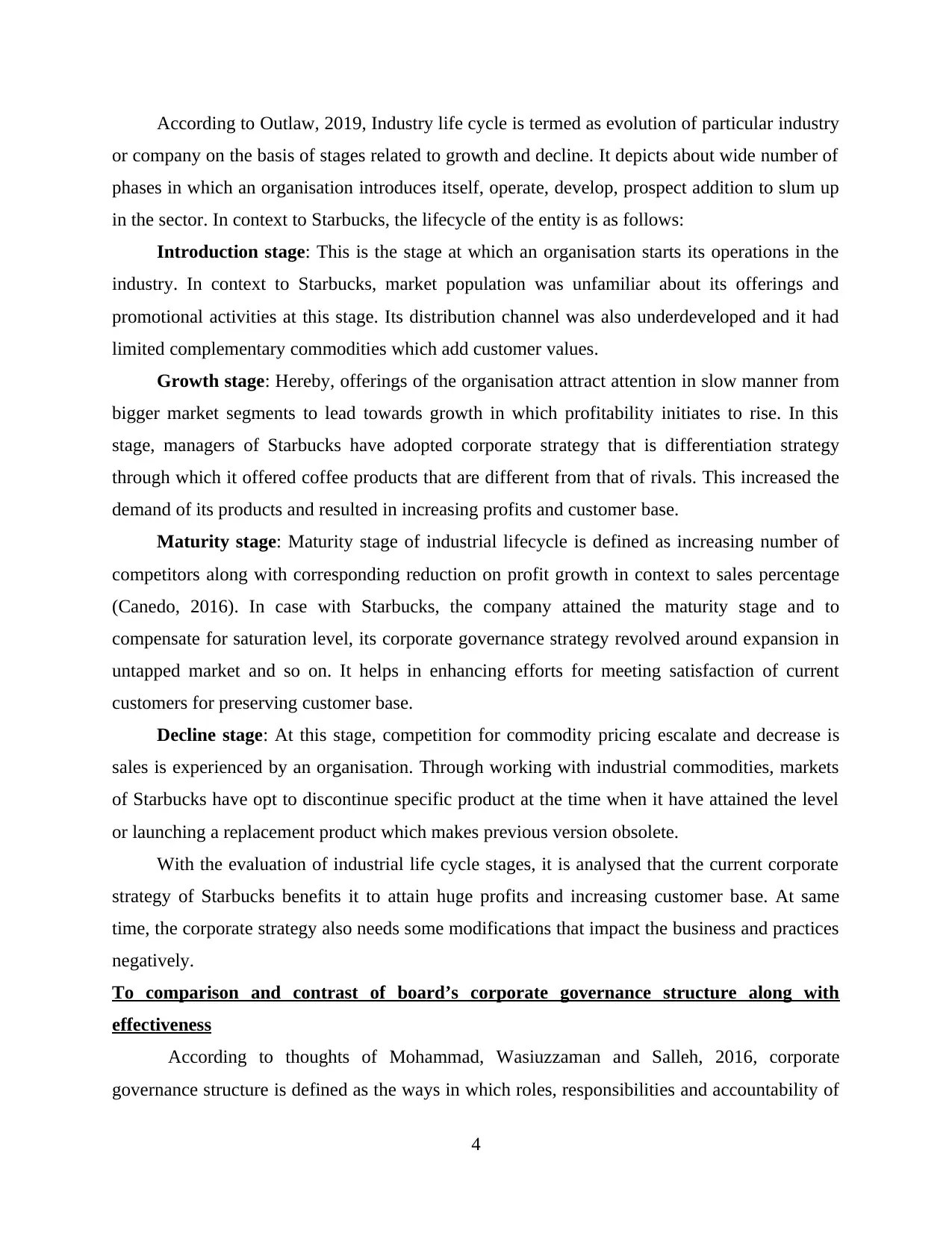
According to Outlaw, 2019, Industry life cycle is termed as evolution of particular industry
or company on the basis of stages related to growth and decline. It depicts about wide number of
phases in which an organisation introduces itself, operate, develop, prospect addition to slum up
in the sector. In context to Starbucks, the lifecycle of the entity is as follows:
Introduction stage: This is the stage at which an organisation starts its operations in the
industry. In context to Starbucks, market population was unfamiliar about its offerings and
promotional activities at this stage. Its distribution channel was also underdeveloped and it had
limited complementary commodities which add customer values.
Growth stage: Hereby, offerings of the organisation attract attention in slow manner from
bigger market segments to lead towards growth in which profitability initiates to rise. In this
stage, managers of Starbucks have adopted corporate strategy that is differentiation strategy
through which it offered coffee products that are different from that of rivals. This increased the
demand of its products and resulted in increasing profits and customer base.
Maturity stage: Maturity stage of industrial lifecycle is defined as increasing number of
competitors along with corresponding reduction on profit growth in context to sales percentage
(Canedo, 2016). In case with Starbucks, the company attained the maturity stage and to
compensate for saturation level, its corporate governance strategy revolved around expansion in
untapped market and so on. It helps in enhancing efforts for meeting satisfaction of current
customers for preserving customer base.
Decline stage: At this stage, competition for commodity pricing escalate and decrease is
sales is experienced by an organisation. Through working with industrial commodities, markets
of Starbucks have opt to discontinue specific product at the time when it have attained the level
or launching a replacement product which makes previous version obsolete.
With the evaluation of industrial life cycle stages, it is analysed that the current corporate
strategy of Starbucks benefits it to attain huge profits and increasing customer base. At same
time, the corporate strategy also needs some modifications that impact the business and practices
negatively.
To comparison and contrast of board’s corporate governance structure along with
effectiveness
According to thoughts of Mohammad, Wasiuzzaman and Salleh, 2016, corporate
governance structure is defined as the ways in which roles, responsibilities and accountability of
4
or company on the basis of stages related to growth and decline. It depicts about wide number of
phases in which an organisation introduces itself, operate, develop, prospect addition to slum up
in the sector. In context to Starbucks, the lifecycle of the entity is as follows:
Introduction stage: This is the stage at which an organisation starts its operations in the
industry. In context to Starbucks, market population was unfamiliar about its offerings and
promotional activities at this stage. Its distribution channel was also underdeveloped and it had
limited complementary commodities which add customer values.
Growth stage: Hereby, offerings of the organisation attract attention in slow manner from
bigger market segments to lead towards growth in which profitability initiates to rise. In this
stage, managers of Starbucks have adopted corporate strategy that is differentiation strategy
through which it offered coffee products that are different from that of rivals. This increased the
demand of its products and resulted in increasing profits and customer base.
Maturity stage: Maturity stage of industrial lifecycle is defined as increasing number of
competitors along with corresponding reduction on profit growth in context to sales percentage
(Canedo, 2016). In case with Starbucks, the company attained the maturity stage and to
compensate for saturation level, its corporate governance strategy revolved around expansion in
untapped market and so on. It helps in enhancing efforts for meeting satisfaction of current
customers for preserving customer base.
Decline stage: At this stage, competition for commodity pricing escalate and decrease is
sales is experienced by an organisation. Through working with industrial commodities, markets
of Starbucks have opt to discontinue specific product at the time when it have attained the level
or launching a replacement product which makes previous version obsolete.
With the evaluation of industrial life cycle stages, it is analysed that the current corporate
strategy of Starbucks benefits it to attain huge profits and increasing customer base. At same
time, the corporate strategy also needs some modifications that impact the business and practices
negatively.
To comparison and contrast of board’s corporate governance structure along with
effectiveness
According to thoughts of Mohammad, Wasiuzzaman and Salleh, 2016, corporate
governance structure is defined as the ways in which roles, responsibilities and accountability of
4
⊘ This is a preview!⊘
Do you want full access?
Subscribe today to unlock all pages.

Trusted by 1+ million students worldwide
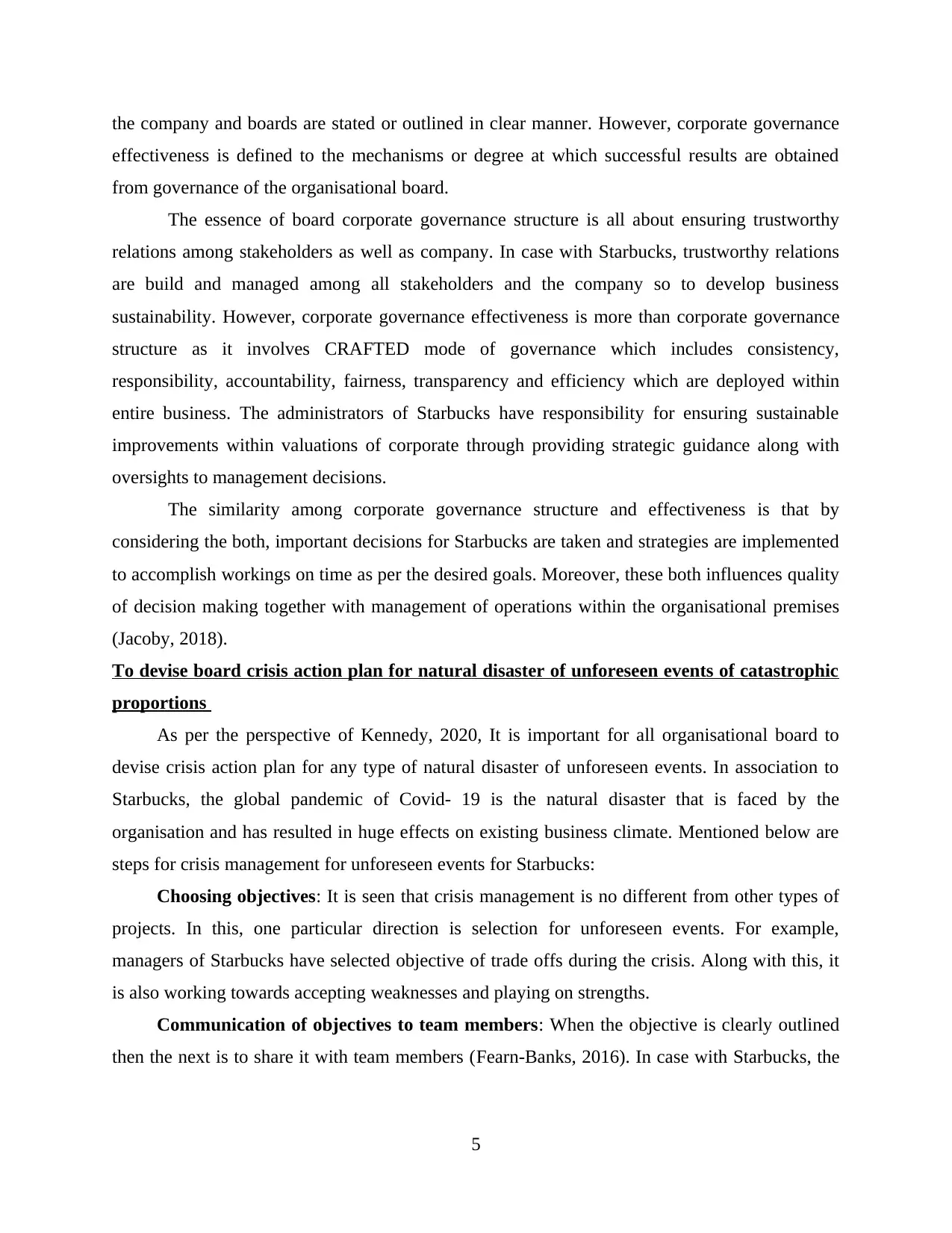
the company and boards are stated or outlined in clear manner. However, corporate governance
effectiveness is defined to the mechanisms or degree at which successful results are obtained
from governance of the organisational board.
The essence of board corporate governance structure is all about ensuring trustworthy
relations among stakeholders as well as company. In case with Starbucks, trustworthy relations
are build and managed among all stakeholders and the company so to develop business
sustainability. However, corporate governance effectiveness is more than corporate governance
structure as it involves CRAFTED mode of governance which includes consistency,
responsibility, accountability, fairness, transparency and efficiency which are deployed within
entire business. The administrators of Starbucks have responsibility for ensuring sustainable
improvements within valuations of corporate through providing strategic guidance along with
oversights to management decisions.
The similarity among corporate governance structure and effectiveness is that by
considering the both, important decisions for Starbucks are taken and strategies are implemented
to accomplish workings on time as per the desired goals. Moreover, these both influences quality
of decision making together with management of operations within the organisational premises
(Jacoby, 2018).
To devise board crisis action plan for natural disaster of unforeseen events of catastrophic
proportions
As per the perspective of Kennedy, 2020, It is important for all organisational board to
devise crisis action plan for any type of natural disaster of unforeseen events. In association to
Starbucks, the global pandemic of Covid- 19 is the natural disaster that is faced by the
organisation and has resulted in huge effects on existing business climate. Mentioned below are
steps for crisis management for unforeseen events for Starbucks:
Choosing objectives: It is seen that crisis management is no different from other types of
projects. In this, one particular direction is selection for unforeseen events. For example,
managers of Starbucks have selected objective of trade offs during the crisis. Along with this, it
is also working towards accepting weaknesses and playing on strengths.
Communication of objectives to team members: When the objective is clearly outlined
then the next is to share it with team members (Fearn-Banks, 2016). In case with Starbucks, the
5
effectiveness is defined to the mechanisms or degree at which successful results are obtained
from governance of the organisational board.
The essence of board corporate governance structure is all about ensuring trustworthy
relations among stakeholders as well as company. In case with Starbucks, trustworthy relations
are build and managed among all stakeholders and the company so to develop business
sustainability. However, corporate governance effectiveness is more than corporate governance
structure as it involves CRAFTED mode of governance which includes consistency,
responsibility, accountability, fairness, transparency and efficiency which are deployed within
entire business. The administrators of Starbucks have responsibility for ensuring sustainable
improvements within valuations of corporate through providing strategic guidance along with
oversights to management decisions.
The similarity among corporate governance structure and effectiveness is that by
considering the both, important decisions for Starbucks are taken and strategies are implemented
to accomplish workings on time as per the desired goals. Moreover, these both influences quality
of decision making together with management of operations within the organisational premises
(Jacoby, 2018).
To devise board crisis action plan for natural disaster of unforeseen events of catastrophic
proportions
As per the perspective of Kennedy, 2020, It is important for all organisational board to
devise crisis action plan for any type of natural disaster of unforeseen events. In association to
Starbucks, the global pandemic of Covid- 19 is the natural disaster that is faced by the
organisation and has resulted in huge effects on existing business climate. Mentioned below are
steps for crisis management for unforeseen events for Starbucks:
Choosing objectives: It is seen that crisis management is no different from other types of
projects. In this, one particular direction is selection for unforeseen events. For example,
managers of Starbucks have selected objective of trade offs during the crisis. Along with this, it
is also working towards accepting weaknesses and playing on strengths.
Communication of objectives to team members: When the objective is clearly outlined
then the next is to share it with team members (Fearn-Banks, 2016). In case with Starbucks, the
5
Paraphrase This Document
Need a fresh take? Get an instant paraphrase of this document with our AI Paraphraser
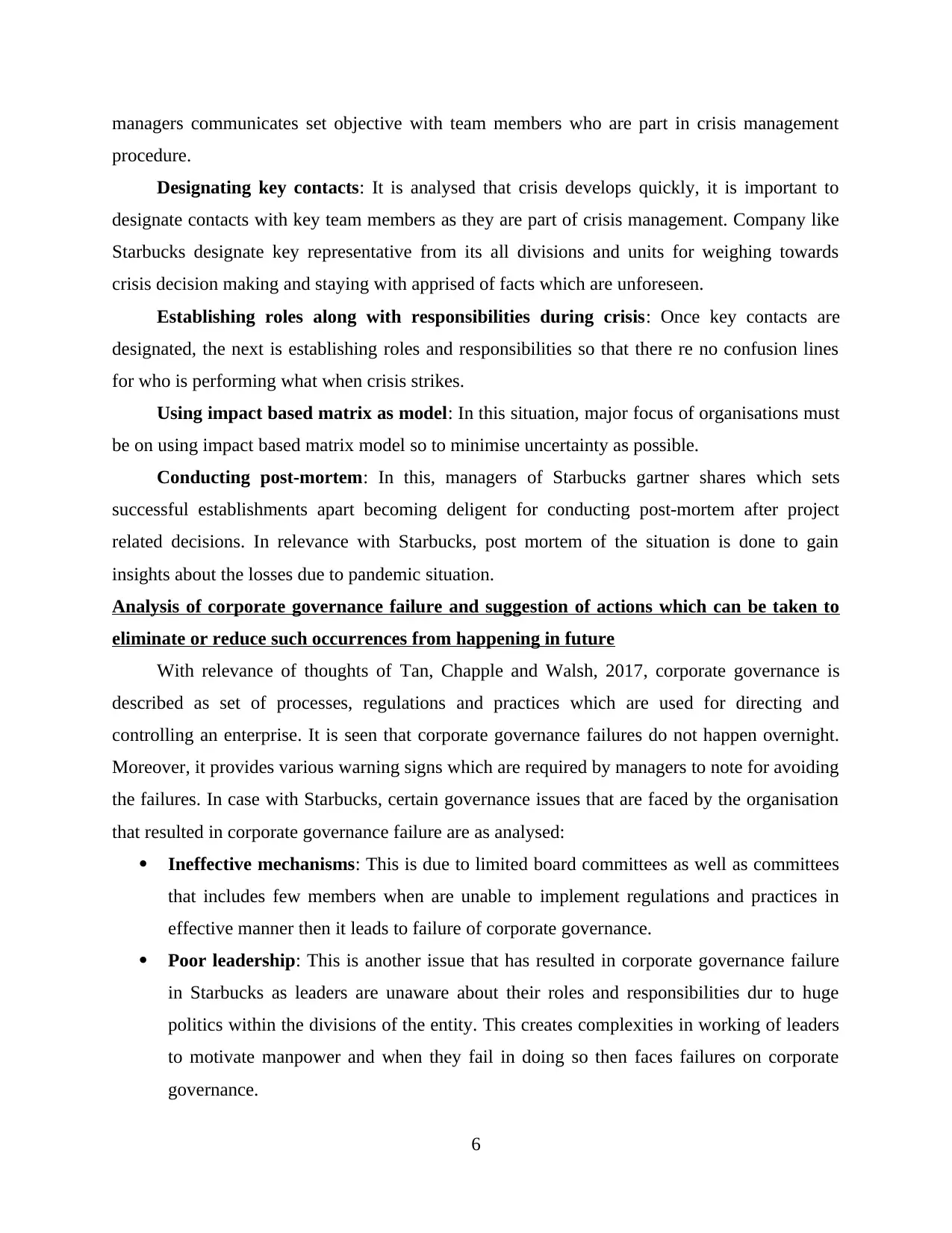
managers communicates set objective with team members who are part in crisis management
procedure.
Designating key contacts: It is analysed that crisis develops quickly, it is important to
designate contacts with key team members as they are part of crisis management. Company like
Starbucks designate key representative from its all divisions and units for weighing towards
crisis decision making and staying with apprised of facts which are unforeseen.
Establishing roles along with responsibilities during crisis: Once key contacts are
designated, the next is establishing roles and responsibilities so that there re no confusion lines
for who is performing what when crisis strikes.
Using impact based matrix as model: In this situation, major focus of organisations must
be on using impact based matrix model so to minimise uncertainty as possible.
Conducting post-mortem: In this, managers of Starbucks gartner shares which sets
successful establishments apart becoming deligent for conducting post-mortem after project
related decisions. In relevance with Starbucks, post mortem of the situation is done to gain
insights about the losses due to pandemic situation.
Analysis of corporate governance failure and suggestion of actions which can be taken to
eliminate or reduce such occurrences from happening in future
With relevance of thoughts of Tan, Chapple and Walsh, 2017, corporate governance is
described as set of processes, regulations and practices which are used for directing and
controlling an enterprise. It is seen that corporate governance failures do not happen overnight.
Moreover, it provides various warning signs which are required by managers to note for avoiding
the failures. In case with Starbucks, certain governance issues that are faced by the organisation
that resulted in corporate governance failure are as analysed:
Ineffective mechanisms: This is due to limited board committees as well as committees
that includes few members when are unable to implement regulations and practices in
effective manner then it leads to failure of corporate governance.
Poor leadership: This is another issue that has resulted in corporate governance failure
in Starbucks as leaders are unaware about their roles and responsibilities dur to huge
politics within the divisions of the entity. This creates complexities in working of leaders
to motivate manpower and when they fail in doing so then faces failures on corporate
governance.
6
procedure.
Designating key contacts: It is analysed that crisis develops quickly, it is important to
designate contacts with key team members as they are part of crisis management. Company like
Starbucks designate key representative from its all divisions and units for weighing towards
crisis decision making and staying with apprised of facts which are unforeseen.
Establishing roles along with responsibilities during crisis: Once key contacts are
designated, the next is establishing roles and responsibilities so that there re no confusion lines
for who is performing what when crisis strikes.
Using impact based matrix as model: In this situation, major focus of organisations must
be on using impact based matrix model so to minimise uncertainty as possible.
Conducting post-mortem: In this, managers of Starbucks gartner shares which sets
successful establishments apart becoming deligent for conducting post-mortem after project
related decisions. In relevance with Starbucks, post mortem of the situation is done to gain
insights about the losses due to pandemic situation.
Analysis of corporate governance failure and suggestion of actions which can be taken to
eliminate or reduce such occurrences from happening in future
With relevance of thoughts of Tan, Chapple and Walsh, 2017, corporate governance is
described as set of processes, regulations and practices which are used for directing and
controlling an enterprise. It is seen that corporate governance failures do not happen overnight.
Moreover, it provides various warning signs which are required by managers to note for avoiding
the failures. In case with Starbucks, certain governance issues that are faced by the organisation
that resulted in corporate governance failure are as analysed:
Ineffective mechanisms: This is due to limited board committees as well as committees
that includes few members when are unable to implement regulations and practices in
effective manner then it leads to failure of corporate governance.
Poor leadership: This is another issue that has resulted in corporate governance failure
in Starbucks as leaders are unaware about their roles and responsibilities dur to huge
politics within the divisions of the entity. This creates complexities in working of leaders
to motivate manpower and when they fail in doing so then faces failures on corporate
governance.
6
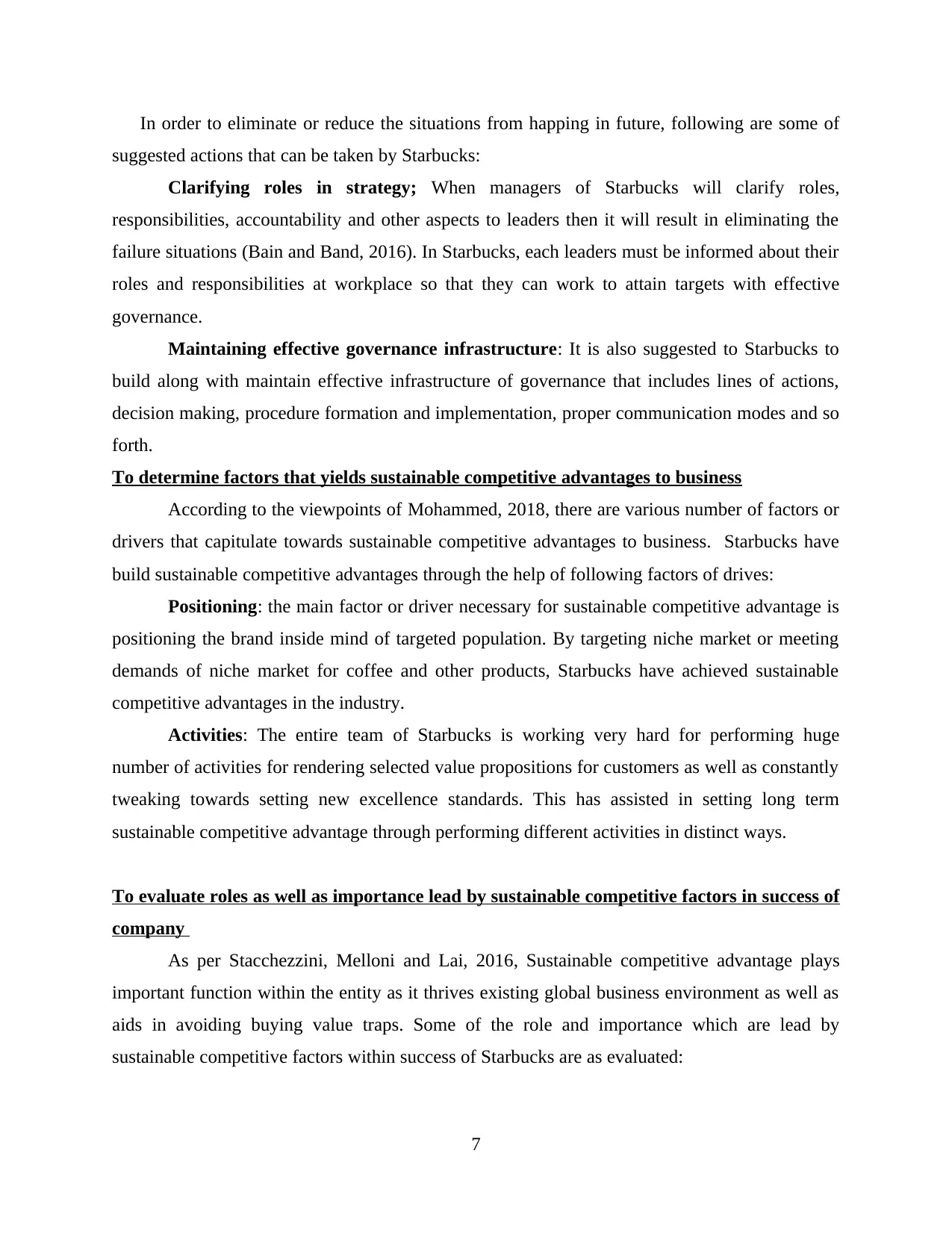
In order to eliminate or reduce the situations from happing in future, following are some of
suggested actions that can be taken by Starbucks:
Clarifying roles in strategy; When managers of Starbucks will clarify roles,
responsibilities, accountability and other aspects to leaders then it will result in eliminating the
failure situations (Bain and Band, 2016). In Starbucks, each leaders must be informed about their
roles and responsibilities at workplace so that they can work to attain targets with effective
governance.
Maintaining effective governance infrastructure: It is also suggested to Starbucks to
build along with maintain effective infrastructure of governance that includes lines of actions,
decision making, procedure formation and implementation, proper communication modes and so
forth.
To determine factors that yields sustainable competitive advantages to business
According to the viewpoints of Mohammed, 2018, there are various number of factors or
drivers that capitulate towards sustainable competitive advantages to business. Starbucks have
build sustainable competitive advantages through the help of following factors of drives:
Positioning: the main factor or driver necessary for sustainable competitive advantage is
positioning the brand inside mind of targeted population. By targeting niche market or meeting
demands of niche market for coffee and other products, Starbucks have achieved sustainable
competitive advantages in the industry.
Activities: The entire team of Starbucks is working very hard for performing huge
number of activities for rendering selected value propositions for customers as well as constantly
tweaking towards setting new excellence standards. This has assisted in setting long term
sustainable competitive advantage through performing different activities in distinct ways.
To evaluate roles as well as importance lead by sustainable competitive factors in success of
company
As per Stacchezzini, Melloni and Lai, 2016, Sustainable competitive advantage plays
important function within the entity as it thrives existing global business environment as well as
aids in avoiding buying value traps. Some of the role and importance which are lead by
sustainable competitive factors within success of Starbucks are as evaluated:
7
suggested actions that can be taken by Starbucks:
Clarifying roles in strategy; When managers of Starbucks will clarify roles,
responsibilities, accountability and other aspects to leaders then it will result in eliminating the
failure situations (Bain and Band, 2016). In Starbucks, each leaders must be informed about their
roles and responsibilities at workplace so that they can work to attain targets with effective
governance.
Maintaining effective governance infrastructure: It is also suggested to Starbucks to
build along with maintain effective infrastructure of governance that includes lines of actions,
decision making, procedure formation and implementation, proper communication modes and so
forth.
To determine factors that yields sustainable competitive advantages to business
According to the viewpoints of Mohammed, 2018, there are various number of factors or
drivers that capitulate towards sustainable competitive advantages to business. Starbucks have
build sustainable competitive advantages through the help of following factors of drives:
Positioning: the main factor or driver necessary for sustainable competitive advantage is
positioning the brand inside mind of targeted population. By targeting niche market or meeting
demands of niche market for coffee and other products, Starbucks have achieved sustainable
competitive advantages in the industry.
Activities: The entire team of Starbucks is working very hard for performing huge
number of activities for rendering selected value propositions for customers as well as constantly
tweaking towards setting new excellence standards. This has assisted in setting long term
sustainable competitive advantage through performing different activities in distinct ways.
To evaluate roles as well as importance lead by sustainable competitive factors in success of
company
As per Stacchezzini, Melloni and Lai, 2016, Sustainable competitive advantage plays
important function within the entity as it thrives existing global business environment as well as
aids in avoiding buying value traps. Some of the role and importance which are lead by
sustainable competitive factors within success of Starbucks are as evaluated:
7
⊘ This is a preview!⊘
Do you want full access?
Subscribe today to unlock all pages.

Trusted by 1+ million students worldwide

Product excellence: The main role played by one of factor that is positioning as
positioning organisational offerings in mindset of customers results in product excellence that
motivates customers to make huge purchase and help the company in attaining sustainable
competitive advantages. It context to Starbucks, it is important as it aids in influencing
purchasing among customers and generating profits for organisation.
Operational excellence: Activity performed by company is other factor that drives
competitive sustainable advantages fro an enterprise. In Starbucks, it plays role of leveraging
operations, visual flows that are seen and understandable by each member of company and so
forth. Moreover, the importance of operational excellence in the company is to develop efficient
systems, eliminating wastage, streamlining procedures, solving complexities in various
operations and catching problems along with implementing solution quickly for attaining
sustainable competitive advantages.
Chapter 3: Discussion on primary and secondary research undertaken for
analysing issues
Research is termed as systematic investigation and study of materials along with sources for
establishing facts together with reaching new customers (Ventresca and Mohr, 2017). Research
methodology is specific technique which is adopted by researcher for the purpose of gathering,
accumulating and assessing entire data. Moreover, it is the tool that helps in collecting relevant
information within particular research study.
Research philosophy: This is significant part of entire research methodology. A research
involves two major research philosophy which can be adopted by the investigator. One is
positivism philosophy that views factual knowledge gained while observation and involves
trustworthy measurements. Positive method only emphasises towards predicting assumptions of
results. The other is interpretivism philosophy that is adopted by researcher for assuming
access to reality through social constructions encompassing consciousness, instruments,
language and shared meanings (Fulford and Hodgson, 2016). In the undertaken research,
Positivism research philosophy is used for the purpose of facilitating better objective reality as
well as adopting scientific way for quantitative along with hypothesis testing related to data
collection and analysing issues that are faced by the company.
Research approaches: There are two research approach types that researcher uses as per the
requirements (Chilisa, 2017). One of research approach is deductive approach which comprises
8
positioning organisational offerings in mindset of customers results in product excellence that
motivates customers to make huge purchase and help the company in attaining sustainable
competitive advantages. It context to Starbucks, it is important as it aids in influencing
purchasing among customers and generating profits for organisation.
Operational excellence: Activity performed by company is other factor that drives
competitive sustainable advantages fro an enterprise. In Starbucks, it plays role of leveraging
operations, visual flows that are seen and understandable by each member of company and so
forth. Moreover, the importance of operational excellence in the company is to develop efficient
systems, eliminating wastage, streamlining procedures, solving complexities in various
operations and catching problems along with implementing solution quickly for attaining
sustainable competitive advantages.
Chapter 3: Discussion on primary and secondary research undertaken for
analysing issues
Research is termed as systematic investigation and study of materials along with sources for
establishing facts together with reaching new customers (Ventresca and Mohr, 2017). Research
methodology is specific technique which is adopted by researcher for the purpose of gathering,
accumulating and assessing entire data. Moreover, it is the tool that helps in collecting relevant
information within particular research study.
Research philosophy: This is significant part of entire research methodology. A research
involves two major research philosophy which can be adopted by the investigator. One is
positivism philosophy that views factual knowledge gained while observation and involves
trustworthy measurements. Positive method only emphasises towards predicting assumptions of
results. The other is interpretivism philosophy that is adopted by researcher for assuming
access to reality through social constructions encompassing consciousness, instruments,
language and shared meanings (Fulford and Hodgson, 2016). In the undertaken research,
Positivism research philosophy is used for the purpose of facilitating better objective reality as
well as adopting scientific way for quantitative along with hypothesis testing related to data
collection and analysing issues that are faced by the company.
Research approaches: There are two research approach types that researcher uses as per the
requirements (Chilisa, 2017). One of research approach is deductive approach which comprises
8
Paraphrase This Document
Need a fresh take? Get an instant paraphrase of this document with our AI Paraphraser
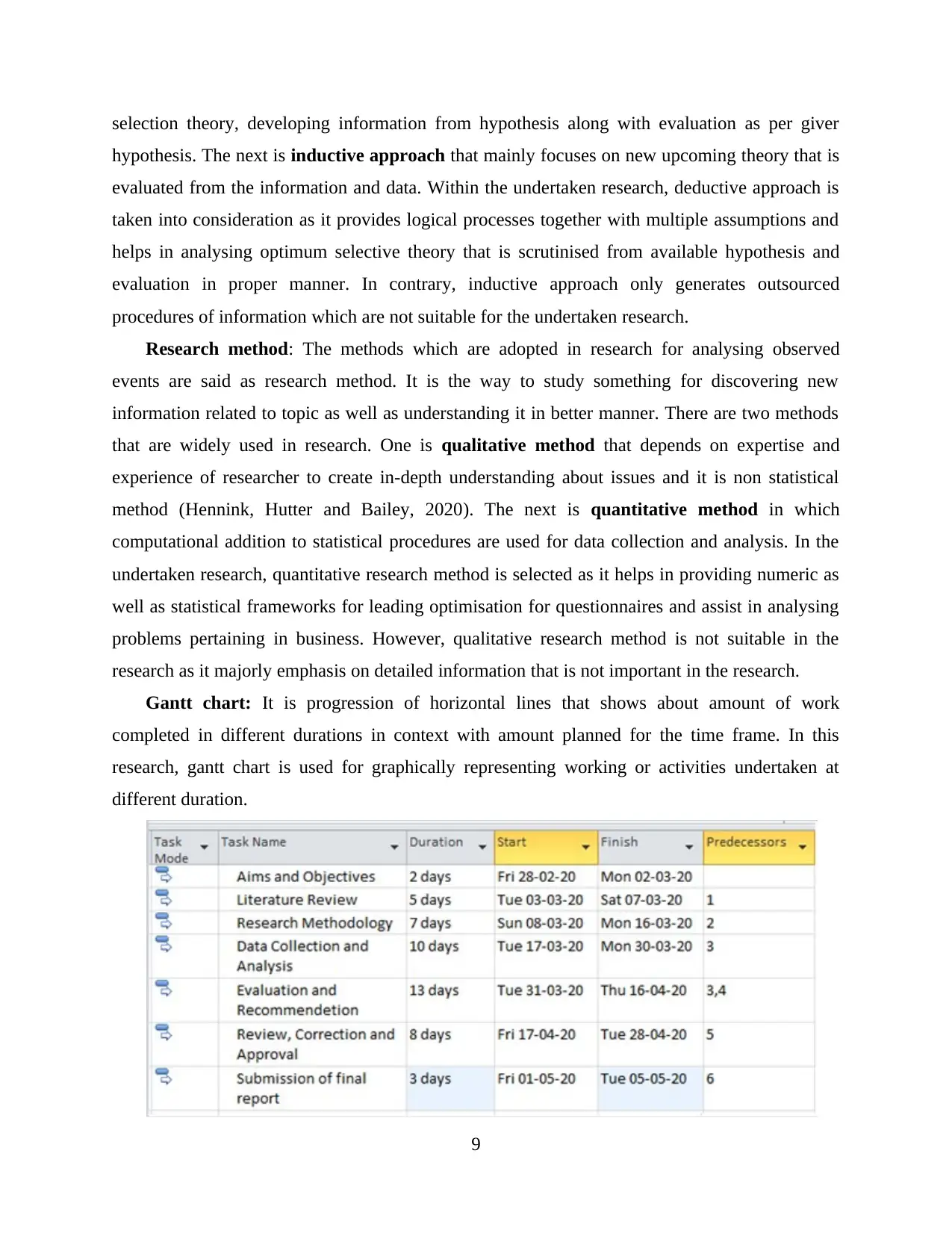
selection theory, developing information from hypothesis along with evaluation as per giver
hypothesis. The next is inductive approach that mainly focuses on new upcoming theory that is
evaluated from the information and data. Within the undertaken research, deductive approach is
taken into consideration as it provides logical processes together with multiple assumptions and
helps in analysing optimum selective theory that is scrutinised from available hypothesis and
evaluation in proper manner. In contrary, inductive approach only generates outsourced
procedures of information which are not suitable for the undertaken research.
Research method: The methods which are adopted in research for analysing observed
events are said as research method. It is the way to study something for discovering new
information related to topic as well as understanding it in better manner. There are two methods
that are widely used in research. One is qualitative method that depends on expertise and
experience of researcher to create in-depth understanding about issues and it is non statistical
method (Hennink, Hutter and Bailey, 2020). The next is quantitative method in which
computational addition to statistical procedures are used for data collection and analysis. In the
undertaken research, quantitative research method is selected as it helps in providing numeric as
well as statistical frameworks for leading optimisation for questionnaires and assist in analysing
problems pertaining in business. However, qualitative research method is not suitable in the
research as it majorly emphasis on detailed information that is not important in the research.
Gantt chart: It is progression of horizontal lines that shows about amount of work
completed in different durations in context with amount planned for the time frame. In this
research, gantt chart is used for graphically representing working or activities undertaken at
different duration.
9
hypothesis. The next is inductive approach that mainly focuses on new upcoming theory that is
evaluated from the information and data. Within the undertaken research, deductive approach is
taken into consideration as it provides logical processes together with multiple assumptions and
helps in analysing optimum selective theory that is scrutinised from available hypothesis and
evaluation in proper manner. In contrary, inductive approach only generates outsourced
procedures of information which are not suitable for the undertaken research.
Research method: The methods which are adopted in research for analysing observed
events are said as research method. It is the way to study something for discovering new
information related to topic as well as understanding it in better manner. There are two methods
that are widely used in research. One is qualitative method that depends on expertise and
experience of researcher to create in-depth understanding about issues and it is non statistical
method (Hennink, Hutter and Bailey, 2020). The next is quantitative method in which
computational addition to statistical procedures are used for data collection and analysis. In the
undertaken research, quantitative research method is selected as it helps in providing numeric as
well as statistical frameworks for leading optimisation for questionnaires and assist in analysing
problems pertaining in business. However, qualitative research method is not suitable in the
research as it majorly emphasis on detailed information that is not important in the research.
Gantt chart: It is progression of horizontal lines that shows about amount of work
completed in different durations in context with amount planned for the time frame. In this
research, gantt chart is used for graphically representing working or activities undertaken at
different duration.
9
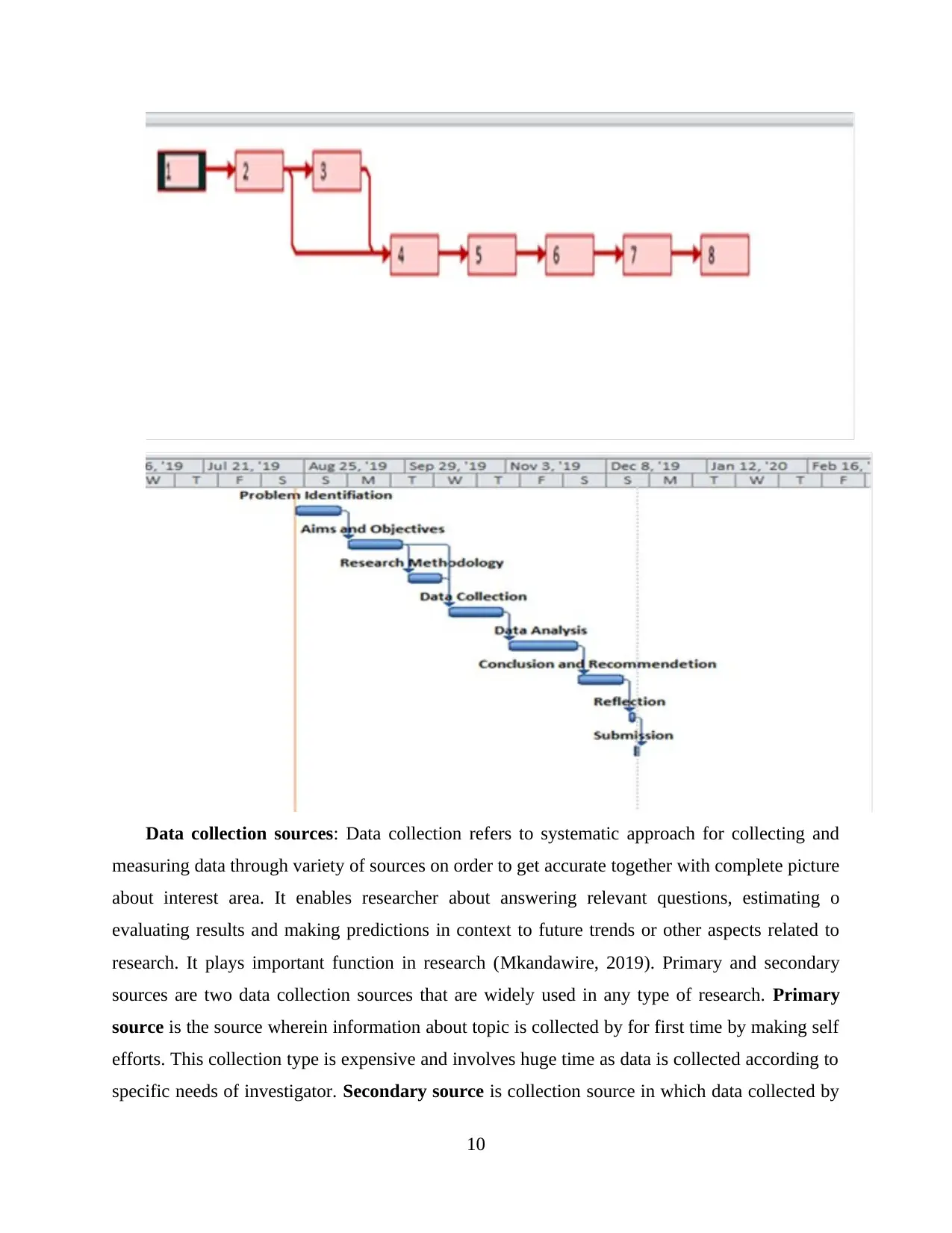
Data collection sources: Data collection refers to systematic approach for collecting and
measuring data through variety of sources on order to get accurate together with complete picture
about interest area. It enables researcher about answering relevant questions, estimating o
evaluating results and making predictions in context to future trends or other aspects related to
research. It plays important function in research (Mkandawire, 2019). Primary and secondary
sources are two data collection sources that are widely used in any type of research. Primary
source is the source wherein information about topic is collected by for first time by making self
efforts. This collection type is expensive and involves huge time as data is collected according to
specific needs of investigator. Secondary source is collection source in which data collected by
10
measuring data through variety of sources on order to get accurate together with complete picture
about interest area. It enables researcher about answering relevant questions, estimating o
evaluating results and making predictions in context to future trends or other aspects related to
research. It plays important function in research (Mkandawire, 2019). Primary and secondary
sources are two data collection sources that are widely used in any type of research. Primary
source is the source wherein information about topic is collected by for first time by making self
efforts. This collection type is expensive and involves huge time as data is collected according to
specific needs of investigator. Secondary source is collection source in which data collected by
10
⊘ This is a preview!⊘
Do you want full access?
Subscribe today to unlock all pages.

Trusted by 1+ million students worldwide
1 out of 35
Related Documents
Your All-in-One AI-Powered Toolkit for Academic Success.
+13062052269
info@desklib.com
Available 24*7 on WhatsApp / Email
![[object Object]](/_next/static/media/star-bottom.7253800d.svg)
Unlock your academic potential
Copyright © 2020–2025 A2Z Services. All Rights Reserved. Developed and managed by ZUCOL.





